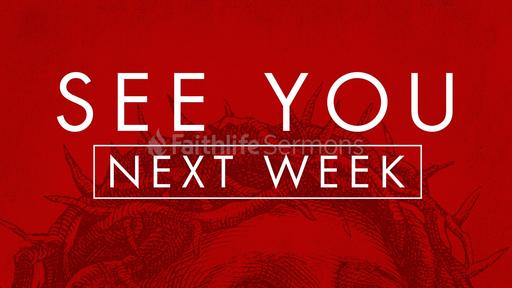Why you think the way you do - Part 3
Sermon • Submitted • Presented
0 ratings
· 16 viewsNotes
Transcript
Summarizing the Medieval Worldview
Summarizing the Medieval Worldview
The medievals assumed that the world was real and that it was created by God with its own integrity but that it also mirrors God’s nature and character.
We, as beings made in the image of God, can understand the world, and thus we can learn both by studying the world itself and by using our reason to interpret the world and its significance.
Since the world was created by a good God and reflects his nature, it is also inherently moral. We can learn moral lessons from the universe, and our laws must conform to natural moral law.
Since we are made in the image of the God who “worked” in creating the world, we are meant to work as well. We each have a calling, which we are to carry out for the glory of God.
Since the world is good, our use of the world’s resources for production is good as well and is sanctified by God. Thus we are free to enjoy the fruits of our labor and to reinvest our profits to further increase production.
Though the world is good, there is also evil in it, and this evil finds its home in the human heart. As a result, governments are necessary to restrain evil, though they themselves are corrupt and need to be restrained through limited government, checks and balances, and the higher laws of nature and reason.
Ultimately, however, nothing in this world can solve the problem of the heart. The solution to our problem is found in grace, penitence, and forgiveness, with the church—identified with Augustine’s City of God—as the sole vehicle through which we can achieve salvation. The institutional church may have had its problems, but to the medieval mind it was the only game in town when it came to salvation. So we are to work hard in our calling, seek virtue and righteousness, and tie into the church’s sacraments and rituals as the means to achieve heaven, the goal and purpose of our lives.
The Breakdown of the Medieval Model
The Breakdown of the Medieval Model
Introduction
Introduction
Starting in the late 1400s Europe the pillars of Medieval thought were being threatened by a series of movements
The Italian Renaissance
The Protestant Reformation
European discovery of America
and a rediscovery of an ancient form of Skepticism
Too much Information: The Italian Renaissance
Too much Information: The Italian Renaissance
The Italian Renaissance is often thought of as this progressive, optimistic, rational and secular way of life. This view of the Renaissance is in all counts wrong. Renaissance means re-birth, its a return to the classical civilization of ancient Greece and Rome.
The Nature of the Renaissance
The Nature of the Renaissance
The short of it Renaissance thinkers thought of Rome as the greatest civilization, when Rome fell, civilization ended. The Medieval thinkers looked at the ancient world as a source of truth, the Italian Renaissance took it to a higher level than their northern counterparts.
While the northerners focused on logic thinking
The Italian Renaissance focused on rhetoric
The greatest Roman rhetorician was Cicero, however he was a pagan and they hung on his every word. This was a problem, especially for Christians when they tried to share the Gospel. As a result, the “Ciceronians” would substitute “Jupiter” for Christ, since Jupiter was the king of the gods.
Because the Renaissance thinkers were obsessed with ancient civilization they collected everything they could from coins, statues, art, building chunks and ancient texts
The Fatal Flaw
The Fatal Flaw
The Renaissance was a victim of its own success. They had accomplished their task of recovering the surviving knowledge of the ancient world, and vast amounts of new texts had been made available. But at the same time, the overwhelming amount of new material caused their broader intellectual project to collapse under its own weight. Of course, the scholastics had weathered this kind of disappointment earlier, and it might be that Renaissance thinkers would have as well, had this been the only problem they were facing. As it is, however, it was only the first of the challenges Europe faced during this period.
Killing for the Prince of Peace: The Reformation and the Wars of Religion
Killing for the Prince of Peace: The Reformation and the Wars of Religion
The second major challenge in Europe was the Protestant Reformation
Essentially this was a theological challenge to the abuse within the church and ended up dividing the Latin world into multiple competing factions.
The new methods of study from the Renaissance led to new answers to old questions so much so that new approaches to Theology could not be accommodated in the Catholic Church.
Protestant Challenges
Questions of Salvation
Protestant argued that we are saved by faith
Catholics argued that we are saved by faith and works
Questions of Sacraments
Protestants believed Sacraments for not needed for forgiveness from sins
Catholics the Sacraments are principle for forgiveness of sins
Questions of Authority
Protestants taking the approach of the Renaissance that to look for truth you could find it in the oldest text. Since the oldest text available for Christians was the Bible they believed that the Bible was sole authority for faith and practice
Catholics believed that the Bible and Tradition were source of authority and tradition guided interpretation of the Bible which made tradition primary.
Protestantism and Worldview
Protestantism and Worldview
The Protestant worldview
All believers were priests
Pastors had a role in the community that was different than lay people but not qualitatively different than other professions.
One’s profession was a calling from God
Protestant areas church and state were more tightly integrated than Catholic areas
The church structure generally reflected the states in which it was in. States with a prince, the church had a bishop that was head. Republican states the church had a council that was head of the church.
While they were integrated with the state, they were always careful to draw boundaries between ecclesiastical and civil responsibilities.
Protestantism was growing fast.
Revitalizing Catholicism
Revitalizing Catholicism
This was largely due to the corruption in the Catholic Church from Pope to parish priest.
Over time the Catholicism would clean up its act to enforce moral standards and responsibilities by clergy taken more seriously.
The Conflict Intensifies
The Conflict Intensifies
The rise of Protestantism and a revitalized Catholic church lead to a lot of questions. Mainly which one was correct and because many dealt in absolutes the choice had and effect on their soul.
Also most believed passionately in their churches and thought of others as superstitious idolaters or heretics.
This was a problem for rulers who thought that religious unity was necessary for the state’s survival, they thought it was their divine responsibility to support the true church.
Examples of Conflicts
Protestant areas was England, where Henry VIII viciously attacked anyone who disagreed with him
Elizabeth I banned Catholic priests from the kingdom (largely because some had been implicated in plots to assassinate her)
Charles V, the Holy Roman emperor, fought the two Wars in an ultimately futile attempt to force Protestant territories to return to Catholicism
Charles’s son Philip II of Spain fought a civil war in his possessions in the Netherlands
The wars in France were unusually destructive, not simply because they lasted so long (from 1562 well into the seventeenth century) but also because the two sides had radically opposing worldviews and thus truly hated each other.
The biggest of these was the Saint Bartholomew’s Day Massacre (1572), in which Protestants in Paris during a truce in the Wars of Religion were butchered in the streets.
The best estimates are that about 2,000 were killed in Paris and perhaps 20,000 across the kingdom, making it the worst mass murder in history prior to the twentieth century.
Political Theory
Political Theory
The religious wars helped bring in two political theories
resistance theory
dealing with the question, “When is it legitimate to resist the government?” The key issue was determining under what circumstances a legal king would become an illegitimate tyrant who could be deposed or even killed.
absolutism
This is the opposite of resistance theory where the only solution was to put more and more power into the hands of the king and to insist on unconditional obedience to him
The idea of the divine right of kings came from this. God placed the king on the throne, so he was answerable only to God. Everyone else must submit to the king’s decisions, since to do otherwise is to resist the person whom God has placed over the kingdom.
Absolutism, Religious War, and its effects
Absolutism, Religious War, and its effects
There were many other Religious wars between Catholics and protestants that people began to ask
Was it truly possible to be so certain about the truth of one version of Christianity over another that it was worth going to war over it? Was religious uniformity so essential to society that it was worth killing people and devastating the country over it?
When these questions were combined with the problems created by the Italian Renaissance, which focused on finding truth and the goal of intellectual life, we have all the ingredients for generating an epistemological crisis all by itself. But there were other worldview challenges to deal with as well.
The Problem of Armadillos: The New World
The Problem of Armadillos: The New World
The discovery of The New World brought out more worldview challenges.
Some Myths first
It has been said that Columbus said out to sail to prove the world was round. Any one that was educated in this time knew the world was round. The reason for the questions from his backers was that they believed there was only one land mass Eurasia and Africa, so they thought that to travel from Europe to Asia would take longer than the required need for water and food to make the trip.
Consulting with a cartographer named Paolo Toscanelli, who convinced him it was about 5,000 miles to Asia, Columbus was able to get the funding and backing. Toscanelli, was off by about 10,000 miles, had Columbus known this he likely wouldn’t have made the trip.
So where did the idea that people thought the world was flat come from. Washington Irving, the writer of The Legend of Sleepy Hollow and Rip Van Winkle. He wrote a biography of Columbus in which he wanted to make Columbus out to be a great man. In order to do this he couldn’t say that Columbus believed bad data from Toscanelli, so he said that Columbus was a great visionary that was first to realize the world was round.
Worldview problems
The problem that the New World raised was not of the shape of the world. It was something worse. When they arrived they found Armadillos, llamas, alpacas, bison, and beavers and a whole host of animals not know to the Old World. They also found people there, lots of them.
This was a real problem because it raised questions about biblical history. The Bible says that Noah build an ark and two of every kind of animal were on the ark along with his three son’s and their wives. The world would be repopulated from Noah’s family and the animals from the animals on the Ark. All the other people and animals were wiped out with the flood.
With all the known animals in Eurasia and Africa, the Ark would have been pretty full, now they have to add all of these new animals to an already full ark.
And where did all of these people come from, they believed that Noah’s three sons were already accounted for—Shem in the Middle East, Ham in Africa, and Japheth in Eurasia. (keep in mind that they did not know about the Land Bridge at the Bering Straits, otherwise this might not have been a problem.)
There was a deeper problem, the goodness of God came into question. Christians believe that Jesus Christ is the only way to salvation of the world. However, there have been numerous generations of people that never had the opportunity to hear the gospel of Jesus Christ. Christian theology suggested that they would all end up in hell, but was that fair? How could a good God do something like that?
The existence of the Native Americans raised troubling moral questions about fundamental Christian doctrine and the goodness of God, along with questions about the historical veracity of the Bible
The Toddler from Hell: Pyrrhonical Skepticism
The Toddler from Hell: Pyrrhonical Skepticism
Who has ever had a toddler that was always asking the question “Why?” Why Why Why? To the frustrating point that parents would just say because. But because is not an answer. That is the jest of a new problem in worldview of this time. There was a man named Pyrrho and he was an anti-philosopher. When philosophers were in the search for truth, Pyrrho was not. Pyrrho was more determined to show that it was impossible to know anything at all. Although he knew that it was impossible to actually make that claim. It is self-contradictory, as soon as you say you can’t know something is a statement about knowing something.
Pyrrhonism was devastating to religion since it was designed to lead people to suspend judgment on any question of belief. It was equally devastating to all other areas, since the same technique that undermined religious belief could also be used to demolish not simply faith but the kind of certainty about truth that was universally recognized as the very definition of knowledge. And without knowledge, there is no metaphysics or ethics, since we cannot know anything about either reality or morality and thus must suspend judgment about them and about the meaning and purpose of life as well.
With the break down of the Medieval views there needed to be a new paradigm for knowledge, the scientific revolution.
A New Paradigm of Knowledge
A New Paradigm of Knowledge
There were a number of fields developing during this time, including anatomy and physiology and chemistry, the changes in cosmology and physics are the most striking and will serve here as an example for the scientific revolution.
The Traditional Model of the Universe
The Traditional Model of the Universe
To understand the changes in cosmology we need to look at the Traditional Model of the Universe
The universe was believed to be made of four basic elements
Earth
Water
Air
Fire
The model of the Universe devised by an Egyptian cosmographer named Ptolemy
Stationary earth at the center of the universe
The heavenly bodies were on a series of crystalline spheres that nested together like a series of Russian dolls
The closest spheres contained planets
including the moon, Mars, Venus, the sun, Jupiter, and Saturn. (Uranus, Neptune, and Pluto are not visible to the naked eye.)
The Moon and Sun were considered planets
The word planet comes from the Greek planaom, meaning “to wander.”
All of them “wandered” around the field of the fixed stars, which were found on the outermost of the nested spheres.
The stars never moved in relation to each other, but the planets did (including the moon and sun)
This explained the motion of the stars and planets in the night sky. Well almost.
The problem was using perfect spheres did not accurately predict their position.
To fix the problem he force fit it
epicycles—circles that contained the planets and rotated around a point on each of the spheres, which in turn rotated around the Earth
deferents—off-center epicycles
equants —which was a way of varying the speed of the planet as it moved around on its epicycle
Long story short all these calculations accurately predicted the positions of the planets
However, as accurate as it was, it still was not perfect and over time the calendar and seasons became off.
This became a problem for the church as it made it difficult to predict the date of Easter
In the Latin world Easter was fixed as the first Sunday after the first full moon after the spring equinox
The church calendar was built around Easter so an interest in calendar reform became a priority.
The Copernican Revolution
The Copernican Revolution
Enter Nicolaus Copernicus - was a brilliant Polish mathematician, scholar, and clergyman
Copernicus and Heliocentrism
Copernicus and Heliocentrism
Copernicus didn’t much like the geocentric model of Ptolemy, he felt that the universe was uniform, perfect and circular motion. So he didn’t much like the epicycles.
He placed the Sun at the center of the universe with the planets on spheres moving out from the sun, and the moon around the earth. However his calculations also didn’t add up so he too added epicycles and when that didn’t work he added double epicycles. Copernicus model once again was a closer model than Ptolemy for predicting the planets.
The Problem with Copernicus’ model include
Difficult math
The biggest problem though was that it raised huge problems for physics during this time.
While Copernicus’ is considered on of the founders of modern science, his methods are much different than our science today. He was a natural philosopher who believed that his model of the universe needed to be linked to aesthetics and to other philosophical ideas
Copernicus also operated within the Christian worldview that argued that the world was rational and beautiful because the God who created it was rational and beautiful, and that we (as rational creatures) could understand God’s creation.
Tycho Brahe and Johannes Kepler
Tycho Brahe and Johannes Kepler
Another popular system was devised by Tycho Brahe, his system was one that the Sun and Moon rotated around the Earth but the other planets rotated around the Sun.
He believed that what was needed for calendar reform was more data. So he convinced the king of Denmark to give him an island that he could build an observatory to collect more data. After collecting all the data he needed someone to help him with the math.
Enter Johannes Kepler, mathematician, a brilliant all-around scholar, a committed Lutheran, an equally committed Copernican, and a Pythagorean.
Because Kepler was a Copernican, Brahe thought he was a nutcase. So he only gave him the data for Mars and told him to not go off and do his own work and work on his model.
Try after try, Kepler could not get Brahe’s data to work with his model, so he put the data in a heliocentric model and things drastically improved. The data was off by a small around but still outside the margin of error for Tycho’s equipment.
Kepler’s next move was to abandon circles and he used an ellipse and the data snapped into place. He later discovered that the planets vary in speed.
Once again, it is important to note the influence of Kepler’s Christian faith. He believed that God had created the universe by using geometry, and through the use of geometry human beings could discover what God did. In this way, following the long tradition of blending the Bible and philosophy, he was able to combine Christian natural philosophy and Pythagoreanism.
Galileo and The Church
Galileo and The Church
This brings us to Galileo
Galileo was a Copernican as well but he ignored Kepler’s work
Galileo based his argument for Copernican on observation instead of math.
Galileo wrote for a popular audience
Galileo also had a nak for making people that disagreed with him look like fools, so he had a number of enemies, including powerful people in the Catholic church.
He was the first to observe the heavens through a telescope and claimed his observations proved a heliocentric model
Many disagreed and they were right to do so.
He observed mountains on the moon proving it wasn’t a perfect sphere
This however doesn’t prove that the earth rotates round the sun
He noted that Venus go through phases, this could indicate it went around the sun. But so did the Tychonic system
Among other observations that had already been discovered by Tycho’s system
What Galileo had was interesting but not proof of a heliocentric system.
Astronomy and The Bible
Astronomy and The Bible
Galileo’s opponents were the first to bring up the problem of the Biblical passages that suggest a stationary earth and moving sun.
They brought this forward maybe because they were theologians
Or they brought it up to get back at Galileo in anyway they could
Galileo’s response:
God Created two books the book of scripture and the book of nature
Both were difficult to understand and the insights of one should be used to help understand the other
He suggested that the Biblical passages needed to be reinterpreted so they could be true while still leaving room for a heliocentric model.
He spent a great deal of time and effort trying to show that the relevant passages made better sense literally in a heliocentric universe rather than in the traditional geocentric one.
Heliocentrism and Heresy
Heliocentrism and Heresy
The Catholic church disagreed and ultimately decided to call the heliocentric model as fact was a heresy, while holding it as a theory was not. This is what finally got Galileo put in house arrest, for writing a comparison of the two models and making heliocentric look much better then geocentric.
Religion and Science?
Religion and Science?
Many use this argument that religion (Christianity ) is against science. When you look at this history of this that is the farthest from the truth. What happened here were arguments of one view of science and Scripture pinned against another view of science and Scripture. It was in no way Scripture against science.
Galileo then started working on moving bodies and ballistics. These studies were Galileo’s most importance contributions to physics. Tt was a critically important contribution to Newton’s theories of gravity and motion.
Answering Pyrrho
Answering Pyrrho
Descartes and Cartesianism
Descartes and Cartesianism
Pascal, Probabilism, and Progress
Pascal, Probabilism, and Progress
Sir Isaac Newton
Sir Isaac Newton
Newton had a troubled childhood, losing his father early, had a horrible stepfather. Ended up being raised by his grandmother.
He was however brilliant in mathematics inventing calculus. Discovered the that white light could be broken down to colors, is discoveries on motion and gravity.
He however was more interested in theology, he devoted a lot of time to Biblical studies. He wanted to understand God through both books Scripture and nature.
Newton and his predecessors not only established a new system of physics but also laid the foundation for a new epistemology in Europe.
This phrase from the book is the most notable
This change in epistemology would inevitably affect the rest of the worldview, since epistemology, ethics, and metaphysics are all interrelated. At the same time, all of the key figures in the scientific revolution were self-consciously working as Christian natural philosophers, with a worldview which said that a rational God would create a rational world, one that we as rational creatures made in the image of God can understand. Unlike the worldviews of other cultures, this fundamental concept made the emergence of science possible.
Next time we will look at how new developments in natural philosophy lead to a movement away from the Christian worldview of the leaders of the scientific worldview. With the upcoming Enlightenment other worldview would have an influence on Western Culture but without displacing Christianity.
ADVERTISEMENT
Related Media
See moreRelated Sermons
See more

Martin Ryszewski • 30 views


Alberto Hernandez • 904 views



